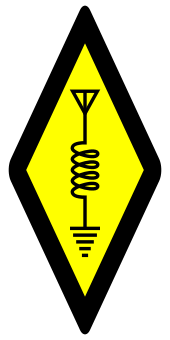History of amateur radio
The history of amateur radio, dates from the dawn of radio communications, with published instructions for building simple wireless sets appearing at the beginning of the twentieth century.[1] Throughout its history, amateur radio enthusiasts have made significant contributions to science, engineering, industry, and social services. Research by amateur radio operators has founded new industries,[2] built economies,[3] empowered nations,[4] and saved lives[5] in times of emergency.
Amateur radio is a hobby and, by law, completely non-commercial. Individual amateur "ham" radio operators pursue the avocation for personal pleasure through building their own radio stations and communicating with their fellows globally, and for self-improvement via study and practice of electronics, computers, and radio and TV wave behavior. Radio amateurs are, thus, "amateurs" in the true sense of the word: pursuit of an activity only for the love of it. Radio amateurs can not broadcast or transmit music and other general public entertainment programming. The amateur radio use of the air waves is for personal satisfaction and for forwarding the "state of the art" of electronics and communication techniques. Amateur radio operations can be detected in designated bands throughout the radio spectrum, using a variety of modulation methods including Morse code, voice and digital modes, and image modes such as television and facsimile.
Beginnings
Amateur radio came into being after radio waves (proved to exist by Heinrich Rudolf Hertz in 1888) were adapted into a communication system in the 1890s by the Italian inventor Guglielmo Marconi.[6] In the late 19th century there had been amateur wired telegraphers setting up their own interconnected telegraphic systems. Following Marconi's success many people began experimenting with this new form of "wireless telegraphy". Information on "Hertzian wave" based wireless telegraphy systems (the name "radio" would not come into common use until several years later) was sketchy, with magazines such as the November, 1901 issue of Amateur Work showing how to build a simple system based on Hertz' early experiments.[1] Magazines show a continued progress by amateurs including a 1904 story on two Boston, Massachusetts 8th graders constructing a transmitter and receiver with a range of eight miles and a 1906 story about two Rhode Island teenagers building a wireless station in a chicken coop. In the US the first commercially produced wireless telegraphy transmitter / receiver systems became available to experimenters and amateurs in 1905.[1] In 1908, students at Columbia University formed the Wireless Telegraph Club of Columbia University, now the Columbia University Amateur Radio Club. This is the earliest recorded formation of an amateur radio club, collegiate or otherwise.[7] In 1910, the Amateurs of Australia formed, now the Wireless Institute of Australia.
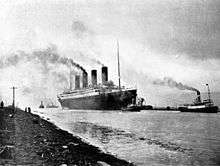
The rapid expansion and even "mania" for amateur radio, with many thousands of transmitters set up by 1910, led to a wide spread problem of inadvertent and even malicious radio interference with commercial and military radio systems. Some of the problem came from amateurs using crude spark-transmitters that spread signals across a wide part of the radio spectrum.[1] In 1912 after the RMS Titanic sank, the United States Congress passed the Radio Act of 1912[8] which restricted private stations to wavelengths of 200 meters or shorter (1500 kHz or higher).[9] These "short wave" frequencies were generally considered useless at the time, and the number of radio hobbyists in the U.S. is estimated to have dropped by as much as 88%.[10] Other countries followed suit and by 1913 the International Convention for the Safety of Life at Sea was convened and produced a treaty requiring shipboard radio stations to be manned 24 hours a day. The Radio Act of 1912 also marked the beginning of U.S. federal licensing of amateur radio operators and stations. The origin of the term "ham", as a synonym for an amateur radio operator, was a taunt by professional operators.[11][12][13]
World War I
By 1917, World War I had put a stop to amateur radio. In the United States, Congress ordered all amateur radio operators to cease operation and even dismantle their equipment.[14] These restrictions were lifted after World War I ended, and the amateur radio service restarted on October 1, 1919.
Between the wars
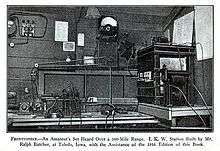
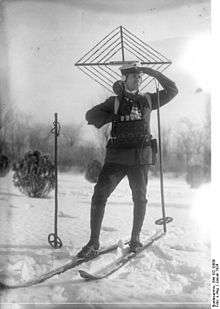
In 1921, a challenge was issued by American hams to their counterparts in the United Kingdom to receive radio contacts from across the Atlantic. Soon, many American stations were beginning to be heard in the UK, shortly followed by a UK amateur being heard in the US in December 1922. November 27, 1923 marked the first transatlantic two-way contact between American amateur Fred Schnell and French amateur Léon Deloy.[15] Shortly after, the first two way contact between the UK and USA was in December 1923, between London and West Hartford, Connecticut.[16] In the following months 17 American and 13 European amateur stations were communicating. Within the next year, communications between North and South America; South America and New Zealand; North America and New Zealand; and London and New Zealand were being made.[17]
These international Amateur contacts helped prompt the first International Radiotelegraph Conference, held in Washington, DC, USA in 1927–28.[8] At the conference, standard international amateur radio bands of 80/75, 40, 20 and 10 meters and radio callsign prefixes were established by treaty.
In 1933 Robert Moore, W6DEI, begins single-sideband voice experiments on 75 meter lower sideband. By 1934, there were several ham stations on the air using single-sideband.[18]
World War II
During the German occupation of Poland, the priest Fr. Maximilian Kolbe, SP3RN was arrested by the Germans.[19] The Germans believed his amateur radio activities were somehow involved in espionage[20] and he was transferred to Auschwitz on May 28, 1941. After some prisoners escaped in 1941, the Germans ordered that 10 prisoners be killed in retribution. Fr. Kolbe was martyred when he volunteered to take the place of one of the condemned men. On October 10, 1982 he was canonized by Pope John Paul II as Saint Maximilian Kolbe, Apostle of Consecration to Mary and declared a Martyr of charity.[19] He is considered the Patron saint of Amateur radio operators.[20]
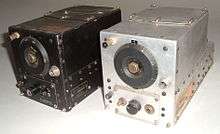
Again during World War II, as it had done during the first World War, the United States Congress suspended all amateur radio operations.[9] With most of the American amateur radio operators in the armed forces at this time, the US government created the War emergency radio service which would remain active through 1945. After the War the amateur radio service began operating again, with many hams converting war surplus radios, such as the ARC-5, to amateur use.
Post war era
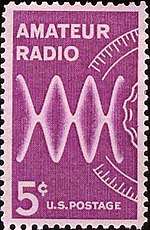
In 1947 the uppermost 300 kHz segment of the world allocation of the 10 meter band from 29.700 MHz to 30.000 MHz was taken away from amateur radio.
During the 1950s, hams helped pioneer the use of single-sideband modulation for HF voice communication.[21] In 1961 the first orbital amateur radio satellite was launched. OSCAR I would be the first of a series of amateur radio satellites created throughout the world.[22]
Ham radio enthusiasts were instrumental in keeping U.S. Navy personnel stationed in Antarctica in contact with loved ones back home during the International Geophysical Year during the late 1950s.[23]
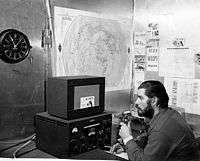
Late 20th century
At the 1979 World administrative radio conference in Geneva, Switzerland, three new amateur radio bands were established: 30 meters, 17 meters and 12 meters.[24] Today, these three bands are often referred to as the WARC bands by hams.
During the Falklands War in 1982, Argentine forces seized control of the phones and radio network on the islands and had cut off communications with London. Scottish amateur radio operator Les Hamilton, GM3ITN[25][26] was able to relay crucial information from fellow hams Bob McLeod and Tony Pole-Evans on the islands to British military intelligence in London, including the details of troop deployment, bombing raids, radar bases and military activities.[27] During 1999 NATO bombing of Yugoslavia, Yugoslav amateur radio operators exchanged information from posts in public shelters.[28] However, owing to an informal code of conduct, radio hams usually avoid controversial subjects and political discussions.[29]
Major contributions to communications in the fields of automated message systems and packet radio were made by amateur radio operators throughout the 1980s. These computer controlled systems were used for the first time to distribute communications during and after disasters.[8]
American entry-level Novice and Technician class licensees were granted CW and SSB segments on the 10 Meter Band in 1987. The frequency ranges allocated to them are still known today throughout much of the world as the Novice Sub Bands even though it is no longer possible to obtain a Novice class license in the US.
Further advances in digital communications occurred in the 1990s as Amateurs used the power of PCs and sound cards to introduce such modes as PSK31 and began to incorporate Digital Signal Processing and Software-defined radio into their activities.
21st century
For many years, amateur radio operators were required by international agreement to demonstrate Morse code proficiency in order to use frequencies below 30 MHz. In 2003 the World radiocommunications conference (WRC) met in Geneva, Switzerland, and voted to allow member countries of the International Telecommunications Union to eliminate Morse code testing if they so wished .[30]
On December 15, 2006, the United States Federal Communications Commission (FCC) issued a Report and Order eliminating all Morse code testing requirements for all American Amateur Radio License applicants, which took effect February 23, 2007.[31] The relaxing of Morse code tests has also occurred in most other countries, resulting in a boosting in the number of radio amateurs worldwide.
While there is no longer a requirement for hams to learn "the Code", it remains a popular communications mode.
Most of Europe allows licensed operators from other countries to obtain permits to transmit in Europe during visits. Residential permits are available in many countries globally whereby a valid license from one country will be honored by other countries under international treaties.
In early 2010, only North Korea had an absolute ban on ham radio operator licenses, although many countries still maintain careful records of ham licensees, and limit their activities and frequency bands and transmit power output.
Amateur radio emergency communications assisted in disaster relief activities for events such as the September 11 attacks in 2001,[32] Hurricane Katrina in 2005,[33] and the Sichuan earthquake in 2008.[34] In 2017, the Red Cross requested 50 amateur radio operators be dispatched to Puerto Rico to provide communications services in the wake of Hurricane Maria.[35]
See also
- Amateur radio licensing in the United States - Contains history of U.S. amateur licensing by the Department of Commerce, the Federal Radio Commission and finally by the Federal Communications Commission.
- Etymology of ham radio
- Women in early radio
Notes and references
- Thomas H. White , United States Early Radio History, Pioneering Amateurs (1900-1917), Early Experimenters
- http://www.bliley.net/XTAL/Industry-Hams.html THE INFLUENCE OF AMATEUR RADIO ON THE DEVELOPMENT OF THE COMMERCIAL MARKET FOR QUARTZ PIEZOELECTRIC RESONATORS IN THE UNITED STATES. By Patrick R. J. Brown, Hewlett Packard Company, Spokane Division
- people.smu.edu/arc/ Inventor of IC "chip", Nobel Prize Winner Jack S. Kilby Credits Amateur Radio for His Start in Electronics.
- "Archived copy" (PDF). Archived from the original (PDF) on 2012-01-19. Retrieved 2014-01-07.CS1 maint: archived copy as title (link) Role of Amateur Radio in Development Communication of Bangladesh. Information & Communication Technology for Development. By Bazlur Rahman
- http://www.arrl.org/news/stories/2004/12/29/100/?nc=1 Amateur Radio "Saved Lives" in South Asia ARRL.org
- Icons of invention: the makers of the modern world from Gutenberg to Gates. ABC-CLIO. 2009. ISBN 9780313347436.
- "Wireless Club at Columbia" The Sun. November 25, 1908. Page 2. New York, NY. - Obtained from Library of Congress Chronicling America project. The article is visible directly below the conspicuous ad for "Hanan Shoes".
- "History of Wire and Broadcast Communication". Federal Communications Commission. Archived from the original on 2007-01-21.
- Coe, Lewis (1996). Wireless Radio: A History Technology. ISBN 0-7864-0259-8.
- DeSoto, Clinton B. 200 Meters & Down, The Story of Amateur Radio. ISBN 0-87259-001-1.
- Ramsey Moreau, Louise. "ARRL History Page".
- "Columbia University Amateur Radio Club". Archived from the original on 2007-01-15. Retrieved 2007-01-10.
- Lombry, Thierry LX4SKY. "History of Amateur Radio, The".
- Laster, Clay (1994). Beginner's Handbook of Amateur Radio, The (3rd ed.). ISBN 0-8306-4354-0.
- "75 Years Ago in Ham Radio". Atlantic Wireless Association. Archived from the original on 1999-08-23.
- "The History of Amateur Radio". RSGB. Archived from the original on August 27, 2006.
- "Early Radio Astronomy: The Ham Radio Connection". NRAO.
- Miccolis, James. "Origin of Ham Speak - Fact, Legends, and Myths". AC6V.com. Archived from the original on 2019-03-25. Retrieved 2007-01-17.
- "Catholic Forum - Maximillion Kolbe". Archived from the original on 2006-03-02. Retrieved 2006-03-01.
- "Famous Hams and ex-Hams". Archived from the original on 2013-07-08. Retrieved 2006-03-01.
- http://www.arrl.org/files/file/Technology/pdf/McElroy.pdf Amateur Radio and the Rise of SSB
- "A Brief History of Amateur Satellites".
- "The Antarctic Sun: Past Connections".
- "The ARRL Letter Vol. 21, No. 19 May 10, 2002".
- "QRZ Callsign Database GM3ITN". Retrieved 2006-03-02.
- "QRZ Callsign Database VP8ITN". Retrieved 2006-03-02.
- Wilson, Giles (June 13, 2002). "BBC News - The Falklands get wired". Retrieved 2006-03-02.
- Erlanger, Steven (1999-03-28). "CONFLICT IN THE BALKANS: IN BELGRADE; A City Shaken By the Intensity Of Latest Raids". New York Times. New York Times.
- H. Ward Silver. The ARRL Ham Radio License Manual: All You Need to Become an Amateur Radio Operator. Technician]. Level 1. American Radio Relay League; 2006. ISBN 978-0-87259-963-5. p. 4–.
- "WRC-03 Modifications to Article 25". Archived from the original on 2006-10-07. Retrieved 2007-01-10.
- "FCC Releases Report and Order in "Morse Code" Proceeding". Archived from the original on 2007-01-07.
- "Remembering the World Trade Center - September 11, 2001". Nyc-arecs.org. Retrieved 2015-05-06.
- "ARRL COO Testifies on Capitol Hill to Amateur Radio's Value in Disasters". ARRLWeb. American Radio Relay League, Inc. 3 Oct 2005. Retrieved 17 February 2010.
- "Chinese Officials Give Kudos to Amateur Radio Operators". American Radio Relay League. 2008-05-27.
- Murphy, Paul P.; Krupa, Michelle. "Ham radio operators are saving Puerto Rico one transmission at a time". CNN.com. CNN. Retrieved 29 September 2017.
- Cain, James D. (2003). YASME: The Danny Weil and Colvin Radio Expeditions. Newington, Connecticut, USA: American Radio Relay League. ISBN 0-87259-893-4
- DeSoto, Clinton B. (1936). 200 Meters and Down: The Story of Amateur Radio. West Hartford, Connecticut, USA: American Radio Relay League. ISBN 0-87259-001-1
- Gregory, Danny and Sahre, Paul (2003). Hello World: A Life in Ham Radio. Princeton Architectural Press. ISBN 1-56898-281-X
- Haring, Kristen (2006). Ham Radio's Technical Culture. The MIT Press. ISBN 0-262-08355-8.
- Messerschmidt, Donald A. (1997). Moran of Kathmandu: Pioneer Priest, Educator and Ham Radio Voice of the Himalaya. Orchard Press. ISBN 974-8299-72-4
- Bartlett, Richard A. (2007) The World of Ham Radio, 1901–1950, A Social History. ISBN 978-0-7864-2966-0
- Lombry, Thierry, LX4SKY, The History of Amateur Radio
External links
- Who was the first radio amateur?
- Amateur Wireless Before 1914 by G.R. Jessop G6JP, Practical Wireless, 1983
- Pioneering Amateurs (1900-1917), United States Early Radio History by Thomas H. White
- Amateur Radio After World War One (1919-1925), United States Early Radio History by Thomas H. White
